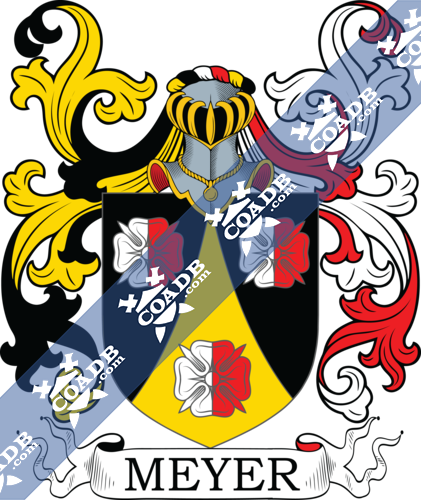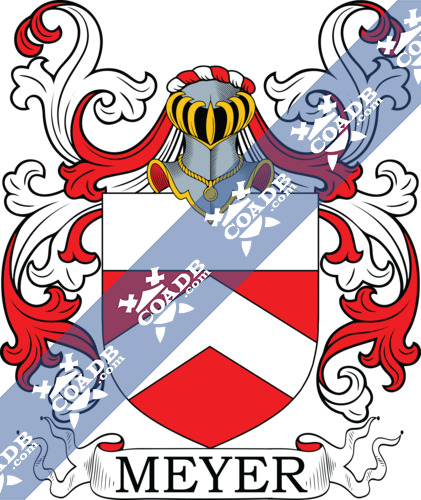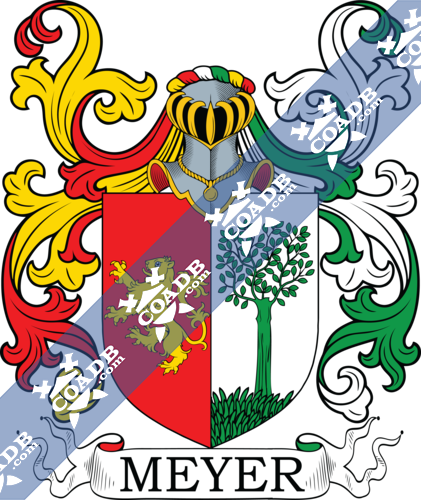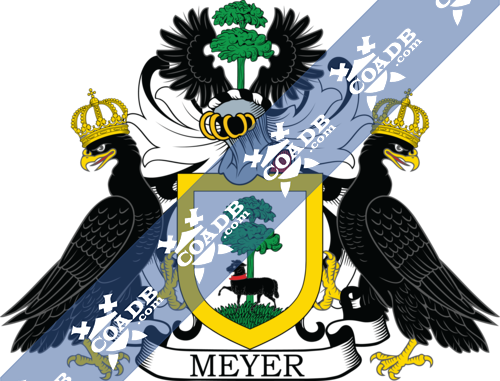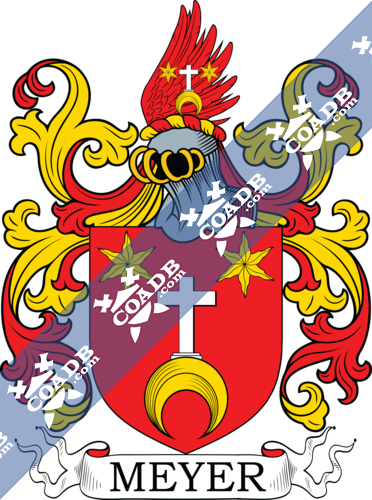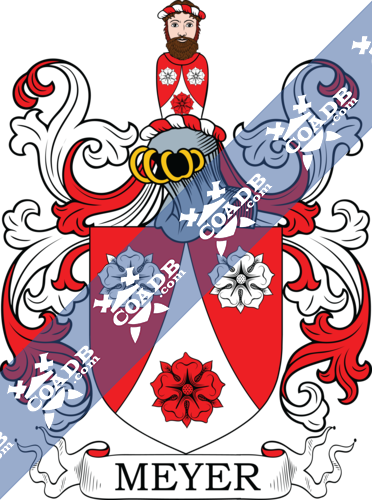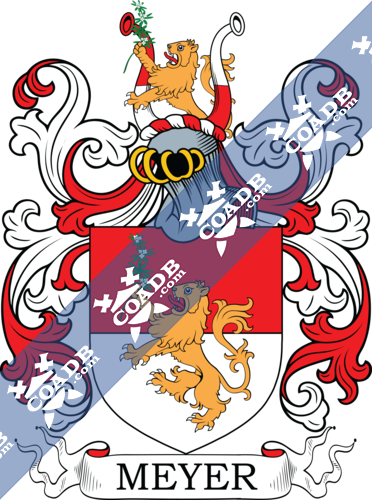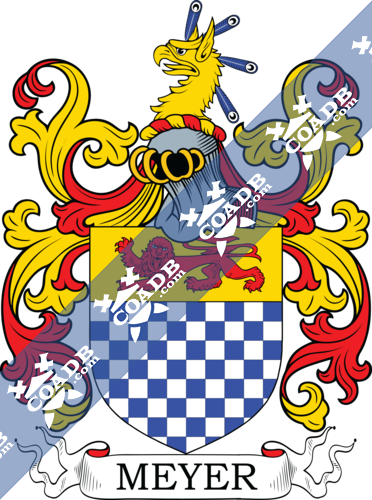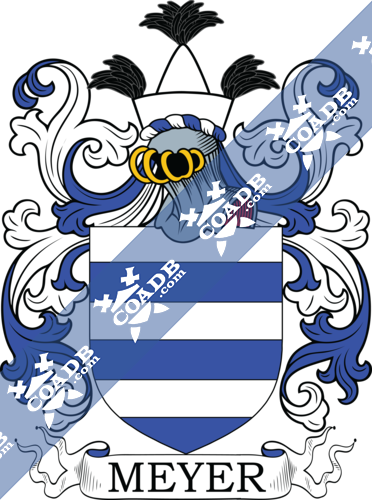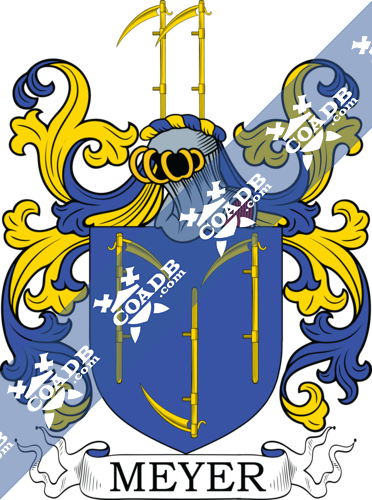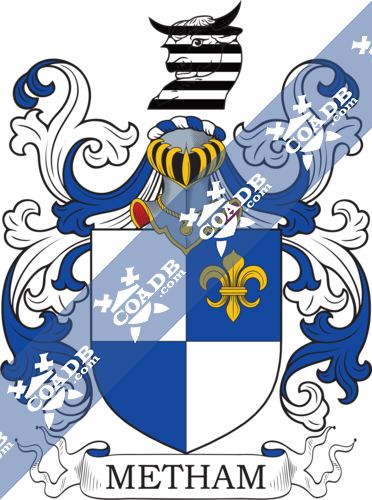Meyer Family Crest, Coat of Arms and Name History

Meyer Coat of Arms Gallery
Don’t know which Coat of Arms is yours?
We can do a genealogical research. Find out the exact history of your family!
Learn MoreSurname Name Meaning, Origin, and Etymology
This Anglo-Saxon surname is a German and Dutch surname that derives from the Middle High German word meier, a status name for a steward, bailiff, or overseer, which later denoted a tenant farmer. It also denoted a village head , or mayor, from the Latin word mayor meaning greater or superior, and the Old English word maire, meaning mayor. In Ireland, it is an Anglicized form of the Gaelic name O Meidhir, from meidhi, meaning mirth. For Ashkenazic Jews bearing this name, it derives it from the Yiddish personal name Meyer, coming from the Hebrew word meir, meaning enlightener or “one who shines”. Some sources also claim it derives from the Roman Latin personal name Magnus, which means “the great one”. The Old French word “mire” means marsh and is another possible etymology. One source also states the name may have referred to a doctor.
In medieval Scotland, the name was a title that denoted an officer who executed summonses and other legal writs, as well as handling other administrative activities. In 1426, the Scottish Act of Parliament, the mair was described as the king’s “Sergeant”, and entitled to bear a wand and horn. In England, the name was bestowed upon the chief civil officer of a borough, but sometimes may have been bestowed on a pompous person as a sobriquet or nickname.
Spelling Variations
Common spelling variants include, but are not limited to, the following: Meyers, Meir, Mayer, Myer, and Meyr. The Danish spelling variation is Meier. The French version is Lemaire. There are numerous surnames containing this name (ex. Niemeyer, Wehrmeyer, Obermeyer, Meyerson, Neumeyer, Hoffmeyer, Strohmeyer, Brockmeyer).
Popularity & Geographic Distribution
The last name ranks Meyer ranks 163rd in popularity in terms in the United Status as of the 2000 Census. The name is particularly common in the Midwest in states such as Minnesota, Wisconsin, Michigan, Iowa, Missouri, Illinois, and Indiana. The variant Meyers ranks 528th, and Meier ranks 1,298th. The name is very common in popular as 5th in terms of popularity. It also ranks 6th in Switzerland, 58th in France, and 1,429th in England.
Early Bearers of the Surname
The use of Meyer as a Jewish personal (first name) is documented as early as 70 AD. One of the earliest recorded bearers was Heinrich Meier of Zurich, Switzerland who was documented in the rolls of that city in 1172 AD. William le Maier was documented in 1243 as living in Somerset and Bartholomew le Meyre in county Norfolk. A one Samuel ben Meir was recorded in the 12th century. The Hundred Rolls of 1273 AD, a census of Wales and England, known in Latin as Rotuli Hundredorum, documents two people bearing this surname: David le Meir in county Lincolnshire and William Mair in county Cambridgeshire, and Willelmus. The Poll Tax of Yorkshire in 1379 lists Willemus Meyre and Matilda Mayre (a laborer). The Register of the University of Oxford records Christopher Maier in county Durham in 1586 AD.
History, Genealogy, and Ancestry
The name originated before the 400s AD during Roman and Frankish times. In England, one source claims the family was first found in Cheshire, and they spread into Lancashire and the east coast. Another source states it was first found in Cheshire at a township in the parish of Rosthern, which was called Mera in the Domesday Book of 1086 AD (a survey of London and Wales ordered by William the Conqueror). An alternative theory is that it originated in Mere in Wiltshire, a market town. In this case, according to the book, A Topographical Dictionary of England, “the name of this place is derived from the Saxon word Maera, signifying bounds and limits, and indicated its situation on the borders of counties Wilts, Somerset, and Doreset. In 1253, permission was given by Henry III to Richard, Earl of Cornwall, to build and fortify a castle on his manor of Mere, and the manor has ever since been attached to the duchy of Cornwall”.
Matthis Mayer was born in 1520 in Heusweiler, Germany (Deutschland). He had a daughter named Katharina born in 1550 who married Hans. They had a daughter named Hans Simon Matthessen.
Johannes Melchoir “Hans” Meyer was born in 1500 in Regensdorf, Zurich, Switzerland. He married Magreth Zimmermand and together they had a son named Hans. Hans was born in 1520, is Schleitheim, Switzerland. She had a son named Melchior, who was born in 1555 and in turn had sons named Hans and Vicenz Meyer. Hans was born in 1580 and had a son named Heinrich. Heinrich was born in 1609 and he married Anna Maria German and they had one issue: Johannes Mayer who was born in 1632 in Heidelberg, Germany. He married Anna Buch and he had two children with her: Johannes Henry, and Henrich. Johannes Henry Mayer was born in 1657 in Alzey, Germany. He married Maria Kaiser in 1682 and Hannah Saugstad in 1668. He left being the following issue: Barbabra Maier, Henrich Christopher Meyer, Anna Maria Meyer, and Henry B. Myers.
A one Carl Meyer was born in 1790 and was the father of Johann Dietrich Wilhelm, who was born in 1816 in Landsesbergen, Prussia. He in turn had a son named Christian Dietrich, who married Carolina Louise Anna Hommert. Prior to his death in 1920 in Bronx, New York, he had a son named Charles C.D. Meyer. Charles was born in 1881 in New York and he had a won named William who was born in 1910. William had a daughter named Paula.
Ulrich Meyer was born in 1680 in Baden-Wurttemberg. He married Johanna Hochstetter and they had a son named Andreas, who was born in 1707 in Merklingen, Germany. He married Barbara Bez and came to South Carolina, USA. They had three issue Ulrichy Mayer, Barbara Margaret (Myers) Siteman, and Andreas Meyers.
Early American and New World Settlers
Early settlers to colonial America include Adolph Meyer (1661 New York), Christopher (1693 Delaware), Abel, Anthony, Arent, Bartel, and Bastiann Meyer (1709 New York). Henry Meyer appeared on a list of convicted rebels taken to Att the Bridewall at Taunton in 1695.
Early settlers in Canada include Barbara and Conrad Meyer who came to Nova Scotia in 1757, as well as John Adolphus George Meyer, a United Empire Loyalist, who came in 1784.
Mottoes
Neither Rietstap’s nor Burke’s lists any mottos for the Meyer family, which is odd for such as long list of blazons. A search on Google shows one motto for the family is Dum spiro spero, meaning “While I live, I hope”, which is depicted on an arms borne by Ludwig Adolph von Meyer (1860 Dresden – 1930 Paris).
Grantees
We have 66 coats of arms for this surname depicted here. They are from Johannes Baptista Riestap’s well-known book Armorial General, published in 1861, which is a comprehensive book of blazons for Europe (particularly Germany, Netherlands, France, Denmark, and Spain). The only exception is the first arms listed on this page (the savage between the two trees), which is listed in Bernard Burke’s General Armory of England, Ireland, and Scotland, which was publishes in 1848. The arms was found in London.
The bottom of this page contains the blazons in both English and French, and in many instances contains some historical, geographical, and genealogical about where coat of arms was found and who bore it. We also have three arms for the name Meyers and six names for Meier on separate pages, please use our search function at the top of the page to locate them.
Notables
Famous people with this last name include: 1) Fred G. Meyer (1886-1978) who was an American the famous grocery store chain Meijer head located through the Midwest and the chain store Fred Meyer, located in the northwest, 2) Ernst Hermann Ludimar Meyer (1905-1988) who was a German composer and musicologist, 3) Adolp Meyer (1881-1929) who was a German architect, and 4) Edward Charles “Shy” Meyer (1928) who was a General in the military and the 29th Chief of Staff of the U.S. Army.
Blazons & Genealogy Notes
1) ou Mayer – Wurtemberg – (An., 6 oct. 1789)Écartelé aux 1 et 4 d’or à une fleur-de-lis de gueules aux 2 et 3 de sable à une rose d’or Casque couronné Cimier une fleur-de-lis de gueules entre deux proboscides coupées alternativement d’or et de sable Lambrequin à dextre d’or et de gueules à senestre d’or et de sable. English: Quarterly 1st and 4th or a fleur-de-lis gules 2nd and 3rd sable a rose or Crest: a fleur-de-lis gules between two proboscides per fess alternately or and sable Mantling: to the dexter or and gules, to the sinister or and sable.
2) Prusse – (An., 16 mai 1729) – Écartelé aux 1 et 4 d’azur au pairle alésé et renversé de gueules acc de trois étoiles d’or au 2 d’argent à la tête de l’aigle de Prusse au 3 d’argent à deux demi-vols adossés de sable Casque couronné Cimier cinq plumes d’autruche alternativement de gueules et d’argent Lambrequin à dextre d’or et d’azur à senestre d’argent et de gueules. English: Quarterly 1st and 4th azure a pall couped and reversed gules accompanied by three etoiles or 2nd argent а head of the eagle of Prussia 3rd argent two single wings addorsed [back to back] sable Crest: five ostrich feathers alternately gules and argent Mantling: to the dexter or and azure to the sinister argent and gules.
3) Prusse – (An., 16 juin 1789) – Parti au 1 d’argent au lion au naturel tenant une épée d’argent garnie d’or au 2 d’argent à trois roses de gueules boutonnées d’or L’écu bordé d’or Cimiers 1° le lion 2° trois plumes de faisan d’argent Lambrequin d’argent et de gueules. English: Per pale 1st argent a lion proper holding a sword argent, hilt and pommell or 2nd argent three roses gules budded or the whole shield with a bordure or Crests: 1st the lion from the shield 2nd three feathers of a pheasant argent Mantling: argent and gules.
4) Prusse – (An., 2 oct. 1776) – Écartelé aux 1 et 4 d’azur à une faucille d’argent aux 2 et 3 d’argent à une palme de sinople et une branche d’olivier du même passées en sautoir Casque couronné Cimier la faucille entre un vol de l’aigle de Prusse Lambrequin d’argent et d’azur. English: Quarterly 1st and 4th azure a sickle argent 2nd and 3rd argent a palm branch vert and a branch of olive of the same placed saltirewise Crest: the sickle between a pair of wings of the eagle of Prussia Mantling: argent and azure.
5) Prusse – (An., 3 avril 1771) – De sinople à deux fasces d’or à trois faucilles d’argent emmanchées du même rangées entre les fasces Casque couronné Cimier un bras armé d’argent brandissant un sabre d’argent garni d’or entre un vol de sable Lambrequin d’or et de sinople. English: Vert two bars or, three sickles argent handles of the same arranged between the bars Crest: an arm armed argent brandishing a sabre argent hilt and pommell or between a pair of wings sable Mantling: or and vert.
6) Prusse – (An., 20 oct. 1769) – D’azur à trois roses mal-ordonnées de gueules boutonnées d’or l’écu bordé du même Casque couronné Cimier trois plumes d’autruche une d’argent entre deux d’azur Lambrequin d’argent et d’azur. English: Azure three roses disordered [1 and 2] gules budded or, the shield with a bordure of the same Crest: three ostrich feathers one argent between two azure Mantling: argent and azure.
7) Lübeck – D’azur à trois faux d’or rangées en fasce les deux extérieures ayant le fer en haut et affrontées celle du milieu ayant le fer en bas et à dextre Cimier deux fers de faux d’or posés en pals accostés le fer en haut. English: Azure three scythes or arranged in fess, the two at the sides having the blades upwards and affrontant [face to face], that in the middle having the blade downwards and to the dexter Crest: two scyte blades or placed palewise side by side the points upwards.
8) Livonie – (Nob. du St-Empire, 23 août 1788) – Coupé au 1 d’or à une faucille d’azur le tranchant dentelé emmanchée au naturel posée en pal au 2 d’azur à trois épis d’or tigés et feuillés de sinople sur une terrasse du même Casque couronné Cimier un bras armé d’argent brandissant une masse à picotons du même Lambrequin à dextre d’or et de sable à senestre d’or et d’azur. English: Per fess 1st or a a sickle azure the blade serrated, handle proper placed palewise 2nd azure three wheat ears or stemmed and leaved vert, placed on a mount of the same Crest: an arm armed argent brandishing a mace with spikes of the same Mantling: to the dexter or and sable to the sinister or and azure.
9) Nuremberg – D’or chapé-ployé de sable à trois roses de quatre feuilles parties d’argent et de gueules 2 et 1 Lambrequin à dextre d’or et de sable à senestre d’argent et de gueules. English: Or chapé-ployé sable three roses each with four leaves per pale argent and gules, 2 and 1 Mantling: to the dexter or and sable to the sinister argent and gules.
10) Posnanie – Les armes de Gozdawa. English: pending
11) P. d’Utrecht – Parti au 1 d’or à une demi-roue de moulin de sable mouvant du parti au 2 d’azur à trois épis d’or posés sur une terrasse de sinople Cimier les épis entre un vol d’azur Lambrequin à dextre d’or et de sable à senestre d’or et de sinople. English: Per pale 1st or a demi mill wheel sable coming from the partition [pale]; 2nd azure three wheat stalks or placed on a mount vert Crest: the wheat stalks between a pair of wings azure Mantling: to the dexter or and sable to the sinister or and vert.
12) Vienne (Dauphiné) – De gueules au chevron d’argent au chef du même. English: Gules a chevron argent a chief of the same.
13) Tyrol, Bavière – (Conc. d’arm., 1701) – Écartelé aux 1 et 4 de gueules à deux bandes ondées d’argent aux 2 et 3 coupé d’or sur gueules au lion de l’un en l’autre Cimier deux proboscides coupées à dextre d’azur sur or à senestre d’argent sur gueules celle à dextre ornée dans son embouchure de trois plumes d’autruche (une d’or entre deux de gueules) et celle à senestre de trois autres plumes d’autruche (d’or d’azur et de gueules) Lambrequin à dextre d’or et d’azur à senestre d’argent et de gueules. English: Quarterly 1st and 4th gules two bends undy argent 2nd and 3rd per fess or over gules a lion counterchanged Crest: two proboscides per fess to the dexter azure over or, to the sinister argent over gules, that to the dexter decorated in its mouthpiece with three ostrich feathers ( one or between two gules ) and that to the sinister with three ostrich feathers ( or, azure and of the gules) Mantling: to the dexter or and azure to the sinister argent and gules.
14) Winterthür – De gueules à une croix latine d’argent soutenue d’un croissant versé d’or et acc en chef de deux étoiles du même Cimier un demi-vol aux armes de l’écu Lambrequin d’or et de gueules. English: Gules a latin cross argent standing on a crescent inverted or and accompanied by in chief of two etoiles of the same Crest: a single wing charged with the arms from the shield Mantling: or and gules.
15) Winterthür, Saint-Gall – Coupé d’argent sur gueules à une rose de l’un en l’autre barbée de sinople Cimier un demi-vol aux armes de l’écu. English: Per fess argent over gules with a rose counterchanged barbed vert Crest: a single wing with the arms of of the shield.
16) Winterthür – De gueules à une fourche de bois d’or à trois dents. English: Gules a wooden fork or with three teeth.
17) Prusse – (An., 6 juillet 1798) – De sinople à une faux d’argent posée en barre le fer à dextre l’écu bordé d’or Cimier un vol de l’aigle de Prusse Lambrequin d’argent et de sable. English: Vert a scythe argent placed bendwise sinister, the blade to the dexter, the shield within a bordure or Crest: a pair of wings of the eagle of Prussia Mantling: argent and sable.
18) Prusse – (An., 6 juillet 1798) – D’argent à un agneau de sable colleté de gueules passant devant un arbre doublement étagé de sinople l’écu bordé d’or Casque couronné Cimier l’arbre entre un vol de sable Lambrequin d’argent et de sable Supports deux aigles regardantes de sable becquées membrées et sommées de couronnes royales d’or. English: Argent a lamb sable collared gules passant in front of a tree with two levels vert, the shield with a bordure or Crest: the tree between a pair of wings sable Mantling: argent and sable Supporters two eagles reguardant sable beaked, legged and surmounted by Royal crowns or.
19) Soleure – D’argent chapé-ployé de gueules à trois roses de l’un à l’autre 2 et 1 Cimier un buste d’homme habillé aux armes de l’écu tortillé d’argent et de gueules. English: Argent chapé-ployé gules three roses counterchanged 2 and 1 Crest: a bust of a man dressed with the arms from the shield wreathed argent and gules.
20) Strasbourg – De sable à trois diamants d’argent rangés en bande. English: Sable three diamonds argent arranged in bend.
21) Strasbourg – D’azur à un rencontre de boeuf de sable langué de gueules portant entre ses cornes une étoile (8) d’or l’écu bordé d’or Cimier le rencontre avec l’étoile Lambrequin d’or et d’azur. English: Azure a head of an ox cabossed sable langued gules carrying between its horns an estoile of 8 points or, the shield within a bordure or Crest: the ox’s head with the etoile Mantling: or and azure.
22) Bâle – D’argent à un bélier rampant de sable accorné et couronné d’or soutenu d’un tertre de sinople Casque couronné Cimier le bélier issant. English: Argent a ram rampant sable, horned and crowned or, standing on a hillock vert Crest: the ram issuant.
23) Baden (Argovie) – Parti au 1 de gueules à un gland d’or à la coque de sinople tigée et feuillée de quatre pièces de sinople la tige en bas au 2 d’azur à un poisson d’argent posé en pal courbé à dextre Casque couronné Cimier un gland d’or à la coque de sinople la tige en bas entre deux poissons d’argent posés en chevron renversé les têtes en haut Lambrequin à dextre de gueules et de sinople à senestre d’argent et d’azur. English: Per pale 1st gules an acorn or, the shell vert, stemmed and leaved of four pieces vert, the stem downwards; 2nd azure a fish argent placed palewise curved to the dexter Crest: an acorn or the shell vert, the stem downwards between two fish argent placed in chevron reversed, the heads upwards Mantling: to the dexter gules and vert, to the sinister argent and azure.
24) Bâle – D’argent à un trèfle de sinople sur un tertre du même Cimier un homme issant habillé d’un parti de sinople et d’argent rebrassé de l’un à l’autre au rabat de l’un en l’autre tenant de sa main dextre un trèfle de sinople la senestre appuyée sur sa hanche. English: Argent a trefoil vert on a hillock of the same Crest: a man issuant dressed per pale vert and argent garnished counterchanged, with flaps also counterchanged holding in its dexter hand a trefoil vert the sinister hand resting on his hip.
25) Berne – De gueules à trois roses d’argent tigées et feuillées de sinople rangées sur un tertre du même Cimier les meubles de l’écu. English: Gules three roses argent stemmed and leaved vert placed on a hillock of the same Crest: the charges of the shield.
26) Bâle – D’or à deux tuyaux d’argent enfoncés l’un dans l’autre soutenus d’un tertre de sinople et surmontés d’un soleil d’or à la bordure de sable Cimier un homme issant habillé d’un parti d’or et de sable tenant de sa main dextre un fer de bêche de sable et de sa senestre une gerbe d’or. English: Or two tubes argent one shoved inside the other supported by a hillock vert and surmounted by the sun or, a bordure sable Crest: a man issuant dressed per pale or and sable holding in his dexter hand the iron of a spade sable and in his sinister a wheatsheaf or.
27) Alsace – (Ex-Libris, XVIIIe siècle) – D’argent à un homme nu de carnation ceint au naturel posé de front sur une terrasse au naturel tenant de sa dextre une faux posée en barre sur son épaule et sa senestre appuyée sur la hanche Cimier un arbre. English: Argent a man naked carnation girded proper, placed facing forwards on a mount vert, holding in his dexter hand a scythe placed bendwise sinister over his shoulder, his sinister hand resting on the hip Crest: a tree.
28) AllemagneÉcartelé aux 1 et 4 d’or à un roc d’échiquier de sable aux 2 et 3 de gueules à deux demi-vols adossés d’argent Cimiers 1° un demi-vol contourné d’or les plumes extérieures alternativement d’or et de sable Lambrequin d’or et de sable 2° un vol d’argent Lambrequin d’argent et de gueules. English: Quarterly 1st and 4th or a chess rook sable; 2nd and 3rd gules two single wing addorsed [back to back] argent Crests: 1st a single wing reversed or, the exterior feathers alternately or and sable Mantling: or and sable; 2nd a pair of wings argent Mantling: argent and gules.
29) Amsterdam – D’argent à trois cotices de gueules Cimier une main posée en pal empoignant une pomme la queue feuillée en haut. English: Argent three bendlets gules Crest: a hand placed palewise holding in its fist an apple the tail leaved upwards.
30) Flandre – D’argent à la fasce de gueules acc en chef de trois merlettes de sable et en pointe d’un rencontre de boeuf du second English: Argent a fess gules accompanied by in chief three merlettes sable and in base the head of an ox cabossed of the second.
31) Autriche – (Conc. d’arm., 6 fév. 1589) – Parti de gueules et d’argent une femme posée de front issante par les genoux de la pointe de l’écu habillée de l’un en l’autre chevelée d’or les cheveux épars tenant de chacune de ses mains levées une rose de l’un à l’autre tigée et feuillée de sinople Cimier la femme issante Lambrequin d’argent et de gueules. English: Per pale gules and argent a woman placed facing forwards, couped trough the knees and issuant from the base of the shield, dressed counterchanged, her hair scattered or, holding in each of her hands upright a rose counterchanged stemmed and leaved vert Crest: the woman issuant Mantling: argent and gules.
32) Autriche – Écartelé aux 1 et 4 d’argent à quatre bandes ondées de gueules aux 2 et 3 coupé d’argent sur gueules au lion de l’un en l’autre Cimier un lion issant de gueules entre deux proboscides coupées d’argent sur gueules ornées chacune dans son embouchure de trois plumes d’autruche de gueules. English: Quarterly 1st and 4th argent four bends undy gules; 2nd and 3rd per fess argent over gules a lion counterchanged Crest: a lion issuant gules between two proboscides per fess argent over gules, decorated each in its mouthpiece with three ostrich feathers gules.
33) Fribourg, Strasbourg – D’argent à la bande de sable ch de deux fers de flèche du champ posés dans le sens de la bande Cimier un buste d’homme habillé aux armes de l’écu tortillé d’argent. English: Argent a bend sable charged with two arrow heads of the field, placed in the direction of the bend Crest: the bust of a man dressed with the arms from the shield, wreathed argent.
34) Francfort-s/Main, Lübeck, Bavière – (Nob. du St-Empire, 14 mars 1789) – D’azur à deux faux d’argent emmanchées d’or passées en sautoir liées d’un ruban de gueules Casque couronné Cimier trois épis effeuillés d’or entre deux proboscides coupées à dextre d’argent sur azur à senestre d’azur sur or Lambrequin conformes aux émaux des proboscides. English: Azure two scytes argent handles or, placed saltirewise tied [banded] together by a ribbon gules Crest: three wheat ears leafless or between two proboscides per fess to the dexter argent over azure to the sinister azure over or Mantling: conforming to the [same as] colours of the proboscides.
35) Hesse – D’azur à deux tiges adossées de sinople fleuries chacune de trois muguets d’argent et mouvant d’une même racine Casque couronné Cimier un bras armé brandissant une épée. English: Azure two stems addorsed [back to back] vert each flowered by three lilies argent and coming from the same root Crest: an arm armed brandishing a sword.
36) Livonie – (Nob. de Suède, 7 août 1645) – Coupé de gueules sur azur à deux faucilles d’argent emmanchées d’or le tranchant dentelé et tourné à dextre accostées brochant sur le coupé Cimier une faucille de l’écu entre un vol de sable Lambrequin d’or d’argent et d’azur. English: Per fess gules over azure two sickles argent, handles or, their blades serrated and turned to the dexter, side by side and covering over the partition line Crest: a sickle as in the shield between a pair of wings sable Mantling: or, argent and azure.
37) Hollande – (An., 17 janv. 1845) – De sable à un fermail rond muni de quatre pièces saillantes faisant face aux bords de l’écu l’ardillon en pal le tout d’or Cimier à dextre trois plumes d’autruche parties chacune de sable et d’or et à senestre trois tiges de sable fleuries chacune au côté senestre de muguets la première tige fleurie de quatre pièces alternativement de sable et d’or et chacune de deux autres de trois pièces une d’or entre deux de sable. English: Sable a buckle with four protruding round pieces facing the edges of the shield, the pin erect palewise, all or Two Crest: 1st three ostrich feathers one or between two sable; 2nd three stems sable each flowered with lilies turned to the sinister, the first stem flowered with four pieces alternately sable and or, each of the other two stems flowered with three pieces one or between two sable.
38) Brandebourg – (An., 1 juillet 1865) – Coupé de gueules sur argent au lion au naturel brochant sur le tout tenant une branche de grateron fleurie au naturel Cimier le lion issant entre deux proboscides coupées alternativement de gueules et d’argent Lambrequin d’argent et de gueules. English: Per fess gules over argent a lion proper covering over the partition line, holding a branch of cleaver flowered proper Crest: the lion issuant between two proboscides per fess alternately gules and argent; Mantling: argent and gules.
39) Berne – De gueules à trois tiges de muguet de sinople rangées sur un tertre du même fleuries chacune de quatre muguets d’argent la troisième tige fleurie au côté senestre les deux autres fleuries au côté dextre Cimier une femme issante habillée d’un parti de gueules et d’argent tenant de chaque main une tige de muguet fleuronné à l’extérieur. English: Gules three stems vert arranged on a hillock of the same, flowered each of four may lillies argent, the third stem turned to the sinister, the other two turned to the dexter Crest: a woman issuant dressed per pale gules and argent, holding in each hand a stem of may lilly, both turned to the exterior side.
40) Coire – Écartelé aux 1 et 4 d’azur à une étoile d’or aux 2 et 3 contre-écartelé de gueules et d’argent Cimier une étoile d’or Lambrequin à dextre d’argent et de gueules à senestre d’or et d’azur (V Mayer à Dortmund et Mayr à Augsbourg). English: Quarterly 1st and 4th azure an estoile or 2nd and 3rd counter quartered gules and argent Crest: an estoile or Mantling: to the dexter argent and gules to the sinister or and azure.
41) France – (Ann. hérald. 1901) – D’azur à trois épis tigés et feuillés d’or Cimier un faucheur tête nue issant habillé d’azur tenant de sa dextre uni faux d’argent appuyée sur son épaule Lambrequin d’or et d’azur. English: Azure three ears of wheat stemmed and leaved or Crest: A mower (reaper), head bald, issuant dressed azure holding in his dexter hand a scythe argent, resting on his shoulder.Mantling: or and azure.
42) Danemark – (An., 22 fév. 1731. M. ét. le 16 nov. 1731) – Parti au 1 de gueules au lion d’or au 2 d’argent à un arbre de sinople terrassé du même. English: Per pale 1st gules a lion or, 2nd argent with a tree vert on a mount of the same.
43) de Meyer – Middelbourg – D’azur à la fasce ondée d’argent acc en chef de trois arbres de sinople rangés sur une terrasse du même et en pointe d’une grue d’argent posée sur une boule d’or la patte dextre levée. English: Azure a fess undy argent accompanied in chief by three trees vert, arranged on a mount of the same and in base a crane argent placed over a ball or the dexter foot raised.
44) de Meyer – Amsterdam – De gueules à trois canettes d’argent au chef du même ch de trois pals du champ. English: Gules three ducks [without beaks or feet] argent, a chief of the same charged with three roundles of the field.
45) (en Allemagne von Mayr) – Hollande – D’argent à un faucheur tenant de ses mains une faux au naturel emmanchée de sable posé sur une terrasse avec un champ de blé dans le fond ledit faucheur habillé d’une veste d’azur sous une redingote grisâtre le haut-de-chausses de sable les bas d’argent les souliers de sable coiffé d’un chapeau du dernier émail Casque couronné Cimier un homme issant posé de profil habillé comme celui de l’écu tenant de sa main dextre une faux posée sur son épaule le bras senestre étendu le long du corps Lambrequin d’argent et d’azur Supports deux lions d’or. English: Argent a mower holding in his hands a scythe proper handle sable, placed on a mount with a field of corn in the background, the aforesaid mower dressed with a jacket azure under a frock coat in greyish colour, high-hose sable with the bottom part argent and shoes sable, on the head a hat of the last; Crest: a man issuant placed in profile dressed as the one from the shield, holding in his dexter hand a scythe placed over his shoulder, the sinister arm extended aside from the body; Mantling: argent and azure Supporters two lions or.
46) dit Rautenfels – Courlande – (An., 1643 ) – De gueules à trois rochers accostés d’argent mouvant de la pointe sommés chacun d’un arbuste de sinople Casque couronné Cimier un cerf issant au naturel couronné d’or Lambrequin d’argent et de gueules. English: Gules three rocks side by side argent coming from the base, each surmounted by a bush vert Crest: a stag issuant proper crowned or Mantling: argent and gules.
47) dit von Salawa und Radau – Silésie – (An., 26 fév. 1876) – Les armes de Habdank le champ d’or et le meuble de gueules. English: The coat of arms of Habdank (Gules łękawica[two chevrons couped, reversed and conjoined] argent, crest: łąkawica as in arms), but the field or and the charges gules.
48) Coupé au 1 d’or à la moitié supérieure d’un poisson d’azur posée en bande acc d’une étoile du même au canton dextre du chef au 2 d’azur à la moitié inférieure d’un poisson d’or posé en barre acc d’une étoile du même au canton senestre du chef. English: Per fess 1st or with the upper half of a fish azure, placed bendwise accompanied by an etoile of the same, placed in the dexter chief point; 2nd azure with the lower half of the fish or, placed bendwise sinister accompanied by an etoile of the same, placed in the sinister chief point.
49) auf Neuburg und Mörsburg – Zurich – Échiqueté d’argent et d’azur au chef d’or ch d’un léopard de gueules Cimier une tête et col de griffon d’or ornée sur la tête et le long du dos de quatre plumes de paon au naturel ou de quatre panaches de plumes de coq de sable Lambrequin d’or et de gueules. English: Checky argent and azure a chief or charged with a lion passant guardant gules Crest: a head and shoulders of a griffin or, decorated over the head and along the back with four peacock feathers proper (alternatively: with four plumes of feathers from cockerel sable) Mantling: or and gules.
50) Meyercrone (anciennement Meyer) – Danemark – (An., 9 nov. 1674. M. ét) – Écartelé aux 1 et 4 de gueules à une tête et col de licorne d’or aux 2 et 3 d’azur à une couronne d’or acc de deux fleurs-de-lis au pied coupé du même 1 en chef et 1 en pointe celle en pointe renversée Casque couronné Cimier sept plumes de héron au naturel. English: Quarterly 1st and 4th gules a head and shoulders of an unicorn or; 2nd and 3rd azure a crown or, accompanied by two fleur de lys couped at the foot of the same, 1 in chief and 1 in base, that in base reversed Crest: seven feathers of a heron proper.
51) d’Altsteten – Appenzell – Fascé d’argent et d’azur Cimier un chapeau piramidal d’argent au rebord du même sommé de trois panaches de plumes de coq de sable un sur le sommet du chapeau et les deux autres sur les extrémités du rebord (V Mayer à Saint-Gall et Mayer-Tschudi). English: Barry argent and azure Crest: a pointed hat argent, the rim of the same, surmounted by three plumes of feathers of a cockerel sable, one over the point of the hat and two over the edges of the hat’s rim.
52) de Balderstorf – Bâle – D’or à une tête de More les épaules habillées de gueules et ailées de sable Cimier un buste de More habillé de gueules tortillé de gueules et d’or la tête sommée de plumes d’autruche de gueules d’azur et d’argent Lambrequin d’or et de gueules. English: Or the head of a Moor, the shoulders dressed gules and winged sable Crest: the bust of a Moor, dressed gules, wreathed gules and or, the head surmounted by three ostrich feathers gules, azure and argent; Mantling: or and gules.
53) de Burglen – Suisse – D’or à une tête et col de buffle de sable bouclée du même Cimier une tête et col de buffle d’argent bouclée de sable. English: Or the head and shoulders of an ox [with ring trough the nostrils] sable, ringed of the same Crest: the head and shoulders of an ox [with ring trough the nostrils] argent, ringed sable.
54) de Hueningen – Bâle – D’or au lion de gueules à la bordure d’azur. English: Or a lion gules, the shield within a bordure azure.
55) de Klinggraeff – Prusse – (An., 23 avril 1803) – Les armes de Klinggraeff qui sont Coupé d’azur à une étoile d’or sur or à trois tourteaux d’azur à la fasce de gueules brochant sur le coupé Casque couronné Cimier une étoile d’or entre deux proboscides coupées à dextre d’or sur azur à senestre de gueules sur or Lambrequin à dextre d’or et d’azur à senestre d’or et de gueules. English: The coat of arms of Klinggraeff : Per fess: 1st azure with an estoile or; 2nd or with three roundels azure; a fess gules covering over the partition line Crest: an estoile or between two proboscides per fess, to the dexter or over azure, to the sinister gules over or Mantling: to the dexter or and azure, to the sinister or and gules.
56) de Schauensee – Munich – (Inc. dans la nob. bavaroise. 28 nov. 1877) – Écartelé aux 1 et 4 d’or à une branche de tilleul feuillée de cinq pièces de sinople plantée dans un tertre de trois coupeaux du même aux 2 et 3 d’or à une étoile (5) renversée de sable Deux casques le 1 couronné le 2 au bourlet de sable et d’or Cimiers 1° un homme issant habillé d’or au rabat de sinople les manches rebrassées-endentées du même coiffé d’un chapeau à larges bords de sable orné de deux plumes de coq d’or à senestre Lambrequin d’or et de sinople 2° une étoile (6) de sable chaque rai orné d’un bouton houppé d’or Lambrequin d’or et de sable. English: Quarterly 1st and 4th or with a branch from a lime tree, leaved with five pieces vert, planted in a hillock with three peaks of the same; 2nd and 3rd or with an estoile of 5 points reversed sable; two helmets, the 1st crowned the 2nd with a wreath on the helmet – sable and or; Crests: 1st a man issuant dressed or with flaps vert the sleeves turned back [of cuffs etc.] of the same, wearing on the head a brimmed hat sable decorated with two feathers of a cockerel or at the sinister side Mantling: or and vert; 2nd an estoile (6 rays) sable, each ray decorated with a tassel or Mantling: or and sable.
57) de Weiler – Souabe – D’argent à un écusson d’azur en abîme ch d’une bande d’or Cimier un cor de chasse d’or en pal le pavillon s’adaptant au casque l’embouchure en haut le dos orné de trois plumes de paon au naturel Lambrequin d’or et d’azur. English: Argent with an escucheon azure in the center fess point, charged with a bend or Crest: a hunting horn or palewise, the bell matching the top of the helmet, the mouthpiece upwards, the back decorated with three peacock feathers proper Mantling: or and azure.
58) d’Urach – Prusse – (An., 3 mars 1791) – Écartelé au 1 d’argent à l’aigle de sable et membrée d’or au 2 parti de gueules et d’argent au 3 parti d’argent et de sinople au 4 d’or à un croissant figuré tourné d’argent Deux casques couronnés Cimiers 1° une queue de paon au naturel 2° un bras armé la main gantelée tenant une épée en fasce le tout au naturel Supports deux griffons de sable becqués d’or les pattes et les jambes du même Manteau de pourpre doublé d’argent. English: Quarterly 1st argent an eagle sable legged or; 2nd per pale gules and argent; 3rd per pale argent and vert; 4th or with an increscent figured [with a face] argent; Crowned with two helments – Crests: 1st a tail of a peacock proper; 2nd an arm armed, the hand gauntleted holding a sword fesswise all proper; Supporters: two griffins sable beaked or, the paws and the legs of the same; Mantle of purpure and argent.
59) von Knonau – Zurich- De gueules à un mortier de président d’argent retroussé d’hermine les cordons d’argent passés en sautoir Casque couronné Cimier un buste d’homme barbu habillé de gueules coiffé d’un mortier de gueules retroussé d’hermine les cordons d’argent passés en sautoir sur sa poitrine. English: Gules a judges cap of the president argent turned up ermine, the strings argent placed saltirewise; Crowned with a helmet Crest: the bust of a man bearded dressed gules, wearing on the head a judges cap gules turned up of ermine, the strings argent placed saltirewise over his chest.
60) (von Sickingen ou Siggingen – Wurtemberg – Armure gravée sur une médaille 1716) De sable à un buste de jeune fille au naturel posé de front. English: Sable the bust of a young girl proper, placed facing forwards.
61) zu Hirzen – Bâle – D’or à un arbre de sinople sur un tertre de gueules Bourlet de gueules et d’or Cimier un cerf issant d’or Lambrequin d’or et de gueules. English: Or a tree vert on a hillock gules Crest: a stag issuant or Mantling: or and gules.
62) von Meyer zu Knonow – Prusse – (Nob. du St-Empire, 20 fév. 1747) – De gueules à un mortier de président d’azur retroussé d’hermine les cordons d’or passés en sautoir réunis dans une houppe d’or Cimier un buste d’homme barbu habillé de gueules coiffé d’un mortier de l’écu Lambrequin d’argent et de gueules. English: Gules a judges cap of the president azure turned up of ermine, the strings placed saltirewise and joined at the bottom in a tassel or Crest: a bust of a man bearded, dressed gules, wearing on the head the judges cap from the shield Mantling: argent and gules.
63) zum Hasen – Bâle – Coupé de sable sur argent à deux béliers courants de l’un en l’autre Cimier un bélier issant d’argent. English: Per fess sable over argent, two rams courant [running] counterchanged Crest: a ram issuant argent.
64) zum Pfeil – Bâle – D’azur à une flèche d’or armée et empennée d’argent la pointe en bas la flèche surmontée d’un croissant versé d’argent à la bordure d’or Cimier un demi-vol d’azur ch du croissant et de la flèche Lambrequin d’argent et d’azur. English: Azure an arrow or armed and flighted [of arrows] argent, the point downwards, the arrow surmounted by a crescent inverted argent, a bordure or Crest: a single wing azure charged with the crescent and the arrow from te shield Mantling: argent and azure.
65) zum Schlüssel – Suisse – Écartelé d’azur et de gueules à la fasce d’or brochant sur le tout Cimier deux proboscides celle à dextre d’argent à la fasce d’or celle à senestre de gueules à la fasce d’or. English: Quarterly azure and gules a fess or covering overall Crest: two proboscides that to the dexter argent with a fess or, that to the sinister gules with a fess or.
66) zu Polling – Bavière – (An., 23 mars 1814) – Les armes de Mayer auf Zaar sauf que les étoiles sont de gueules et que le casque n’est pas couronné. English: The coat of arms of Mayer auf Zaar (Argent a chevron ploye gules between tree estoiles of six points or), but the etoiles are gules and the helmet is not crowned.

